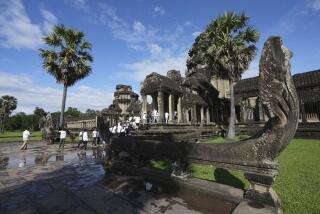Visiting Buddha Is Strictly a Matter of Some Temple Hopping
- Share via
PAGAN, Burma — To understand the visual impact of more than 5,000 Buddhist pagodas and temples spread around this village, one would have to place all the temples of Greece or the archeological wonders and ruins of Egypt, Italy or Mexico in one small area of central Burma.
While those treasures span most of recorded time, Pagan’s temples were built between AD 1057 and AD 1287.
The ancient kingdoms of Pagan go back to the early Christian era, but the golden age began during a period of transition from Hinduism and an earlier form of Buddhism to the current Buddhist beliefs.
But Pagan’s time of power and glory ended when the Tatar hordes of Kublai Khan so threatened the town that it was surrendered in 1287.
Today’s village of Pagan is only one of many in the area, yet it is the center of activity. The market alone is a fascinating study of rural Burmese life.
To enjoy the real beauty of the city, rent a horse carriage and ride through the honeysuckle, frangipani bushes and a panoply of exotic flowers and trees that form a setting for these memorials to Buddha.
Here to there: United, Singapore, Japan and China airlines will get you to Bangkok from LAX. Thai and Burma airlines fly Bangkok-Rangoon. Burma Airways flies on to Pagan in just over an hour.
How long/how much? At least two days for the most beautiful spot in Burma. The government still gives visas for seven days, usually two each for Rangoon, Mandalay and Pagan, one for Heho. Lodging and dining is cheap in Pagan, but the choices are slim.
A few fast facts: Burma’s kyat (pronounced chat ) recently traded at 7 to the dollar, about 14 cents each. Due to the extreme difficulty for an individual to get Burma Airways tickets for domestic travel, plus numerous other hassles, you’ll probably be with Tourist Burma guides all the way, including hotels and meals.
They work with U.S. companies such as Odyssey Tours of Santa Monica or Thai Airways. Plan about $1,100 per person for hotels, meals, transportation and guides for a seven-day stay.
Mid-October to February is the coolest season. It’s hot from then until mid-May, with heavy rains from May through October.
Getting settled in: Your choice is simple--the Thiripyitsaya Hotel ($25 double), a complex of half a dozen buildings in Burmese style, each with four units of a double room, private bath, air conditioning and veranda. Flower-lined pathways connect them to the main building, which has a lobby, bar, restaurant and a cool terrace facing the river.
The Thiripyitsaya also has a fridge in each room, plus rather Spartan baths. Entertainment on some evenings: puppet shows, traditional dancing, etc. It is about the only place to stay in Pagan, give or take a couple of $2-a-night, government-run inns and cooperatives that are definitely substandard.
Regional food and drink: In most hotels you’re offered Burmese, Chinese or continental food, but what you get is Burmese. The meal is usually built around rice, sometimes the sticky variety. Add curried beef, pork and chicken or, at times, fish, none memorable.
Tea, coffee and lime juice with soda water are always served. The beer is a little malty for our taste. It’s often in short supply, however, because there’s only one brand, Mandalay. The only dessert was bananas. Great mounds at every meal but breakfast.
Moderate-cost dining: You’ll probably be with Tourist Burma, which always manages to get you back to your hotel for meals. At the Thiripyitsaya this means juice, eggs, toast and coffee or tea for breakfast, with an interchangeable lunch or dinner much like the food already described.
With chicken or beef there is usually a couple of vegetables, quite good, and a salad, which we always shunned although the ingredients are washed. Local water in Burma is chancy, so drink the bottled variety.
On your own: Temples and pagodas are Pagan’s major attraction. Tourist Burma guides always take you to the most important ones. You should visit Ananda Temple, an impressive structure containing four, 30-foot, golden statues of Buddha. Ananda was built in 1091, its gigantic and intricate towers reaching boldly skyward.
Smaller Kubyaukgyi Temple was built a century later. Its impressive wall paintings date from construction, and are the oldest remaining in Pagan. Kubyaukgyi was being restored by a team of French archeologists during our visit.
Thatbyinnyu Temple is Pagan’s highest, reaching 200 feet. It is preferred for watching sunsets. It’s a stiff climb to the top, but worth it for the stunning views of the temples, pagodas and villages along a graceful curve of the Irrawaddy River.
Also spend some time in the village market watching the Burmese hawk their duck eggs, betel nut powder, cheroots and huge piles of fruits. A ragtag band is a fixture on the street in front of the market, playing music like you’ve never heard before.
Shopping is excellent for lacquered products and wall hangings, the latter in fabric bas-relief and gorgeous colors.
You may make purchases in kyat or by bartering. The government frowns on street exchanges of foreign currency, but bartering is accepted in unofficial shops.
Plan to stop in at the new Pagan Museum for a preview of the history and artifacts found in the temples. At the Irrawaddy river front, watch small boats come and go as village women do their washing while children splash about.
For more information: Burma doesn’t have a tourist office, but tour operators will supply information, itineraries and costs. Call Odyssey Tours at (213) 453-1042 or your travel agent.
More to Read
Sign up for The Wild
We’ll help you find the best places to hike, bike and run, as well as the perfect silent spots for meditation and yoga.
You may occasionally receive promotional content from the Los Angeles Times.





